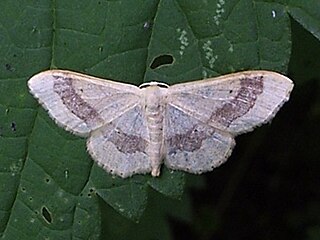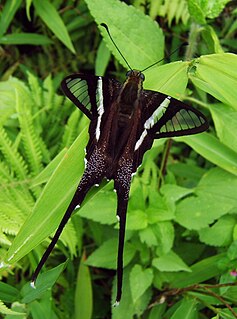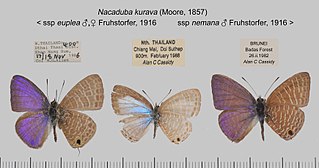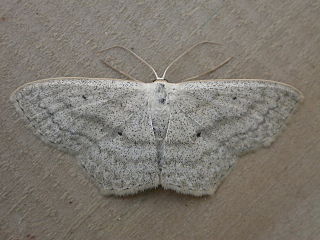
The riband wave is a moth of the family Geometridae. The species was first described by Carl Linnaeus in his 1758 10th edition of Systema Naturae.

The currant pug is a moth of the family Geometridae. The species was first described by Henry Doubleday in 1856. It is found across the Nearctic and Palearctic regions .Its occurrence extends eastwards to the Near East, Urals, the Ussuri region and on to the island of Sakhalin. In the Pyrenees and the Alps it rises to altitudes of 1500 and 1800 metres respectively.

Lamproptera curius, the white dragontail, is a species of swallowtail butterfly native to parts of South Asia and Southeast Asia where it is common. It belongs to the dragontails genus, Lamproptera, of the swallowtail family, Papilionidae.

Tarucus theophrastus, the common tiger blue, pointed Pierrot or African Pierrot, is a small butterfly found in the Old World tropics. It belongs to the lycaenids or blues family.

Nacaduba kurava, the transparent six-line blue, is a Lycaenidae butterfly found in Asia and Australia. The species was first described by Frederic Moore in 1857.

Vindula erota, the common cruiser, is a species of nymphalid butterfly found in forested areas of tropical South Asia and Southeast Asia.

Ancema blanka, the silver royal, is a species of lycaenid or blue butterfly found in the Indomalayan realm. The species was first described by Lionel de Nicéville in 1894.

Tajuria melastigma, the branded royal, is a species of lycaenid or blue butterfly found in the Indomalayan realm.

Gangara lebadea, the banded redeye, is a species of hesperid butterfly found in Southeast Asia.

Scopula imitaria, the small blood-vein, is a moth of the family Geometridae. It was first described by Jacob Hübner in 1799 and it is found throughout Europe and in North Africa.

Scopula nigropunctata, the sub-angled wave, is a moth of the family Geometridae. It is found through most of the Palearctic realm.

Erateina is a genus of moths in the family Geometridae erected by Edward Doubleday in 1848.

Metacrias strategica is a species of moth in the family Erebidae. This species is endemic to New Zealandwhere it is known from the southern part of the South Island. The female of the species is flightless and pale brown, grey or yellowish-brown in colour where as the male is brightly coloured and flies during the day.

Papilio erithonioides is a species of swallowtail butterfly from the genus Papilio that is found in Madagascar. The habitat consists of forests.

Pseudohaetera hypaesia, the hypaesia satyr, is a butterfly species from the subfamily Satyrinae in the family Nymphalidae.

Parides aglaope is a species of butterfly in the family Papilionidae. It is found in Brazil and Bolivia.

Riodina lysippus is a species of Neotropical metalmark butterfly. It is the type species of its genus and of the entire family Riodinidae. It is found throughout northern parts of South America and the Caribbean.

Notoreas niphocrena is a species of moth in the family Geometridae. It is endemic to New Zealand.

Notoreas simplex is a species of moth in the family Geometridae. It is endemic to New Zealand.

Ichneutica paracausta is a moth of the family Noctuidae. This species is endemic to New Zealand. It is found locally in the central North Island, is widespread in the South Island and can also be found in Stewart Island. I. paracausta is variable in colour, but as it has a distinctive black streak on its forewing as well as a wing pattern that is characteristic, I. paracausta is unlikely to be confused with other species. It is present on the North Island volcanic plateau as well as Little Bush Reserve in Hawkes Bay in the North Island as well as in tussock grassland, alpine and subalpine shrubland and in alpine forest. Larvae have been recorded as feeding on grasses, a pupa has been found in a cocoon under the bark of a tree and adult moths are on the wing from October to January.




















